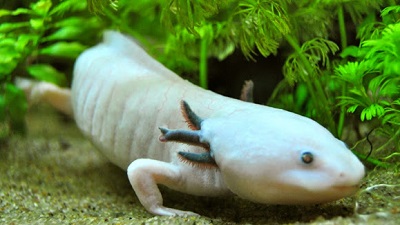0
Taxonomy

Axolotl from the Vancouver Aquarium. The axolotl is classified as critically endangered by the IUCN Red List of Endangered Species.
- Kingdom: Animalia
- Phylum: Chordata
- Class: Amphibia
- Order: Caudata
- Family: Ambystomatidae
- Genus: Ambystoma
- Species: Ambystoma mexicanum
Name
- Scientific name: Ambystoma mexicanum
- Common name: Axolotl, Mexican salamander, Mexican walking fish, Ajolote.
0
Distribution and Habitat
- The axolotl is an amphibian native to central Mexico specifically to the high altitude, fresh water lakes Xochimilco and Chalco south of Mexico City.
- Their distribution is fragmented due to the decline of the quality and extension of its habitat.
- Lake Chalco has been drained for drinking water and no longer exists.
- Lake Xochimilco is only a network of canals and lagoons.
- In its native habitat they live in muddy bottoms rich in biodiversity. They need abundant aquatic vegetation to lay eggs.
- Axolotls are almost extinct in its natural habitat due to habitat loss and predatory fishes.
Physical Features
- Adult axolotls range from 8 to 11 inches or 20 to 28 cm in length.
- On average an adult axolotl weighs 2.11 to 3.88 oz or 60 to 100 gr.
- In captivity they occur in different colors such as gray, brown, leucistic (white with black eyes), golden albino, white albino and melanoid.
- In the wild they are black, brown or cream or any color in between.
- Axolotls have healing and regeneration abilities, capable of re growing lost limbs.
- They retain their larval characteristics in mature adults.
- They have feathery external gills and tail for swimming and underdeveloped legs.
Neoteny
- Axolotls exhibit a phenomenon known as neoteny. They remain in their larval form throughout their lives without going through metamorphosis like other amphibians. Amphibians metamorphose from egg to larva to adult form.
- Neoteny is found in other amphibians and it is generally caused by low levels of iodine, low temperatures or mutation, all of which inhibit the production of thyoroxine hormones necessary for growth and development.
- When treated with hormones, the axolotl will metamorphose resembling the Mexican tiger salamander (Ambystoma velaci).
- The axolotl neoteny is genetic and occurs naturally.
Behavior
- Axolotls are aquatic animals.
- They are solitary except during mating.
- They communicate using visual cues.
Diet
- They eat worms, crustaceans, fish, insects and tadpoles.
Reproduction
- Axolotls reach reproductive maturity at around 1 year of age and are polygynandrous.
- Spawning takes place from a few hours to 2 days.
- Eggs are laid individually on plants.
- A female lays from 100 to 1000 eggs in one spawning, depending on the size of the female.
- Eggs hatch after 14 days. Larvae will eat anything it finds and are immediately independent.
Life Expectancy
- On average they life from 5 to 6 years in captivity.
Threats
- The axolotl is almost extinct in its native habitat due to pollution of the canal system, water channels and lakes.
- Urbanization and consumption of the species as food and for medicinal purposes.
- Newly introduced fish such as carp and tilapia is competing for food and are predators of axolotls.
Conservation Status
- The axolotl is considered a “critically endangered” species by the IUCN Red List of Endangered Species.
Did you know?
Axolotl is the salamander species most easily bred in laboratories. It serves as a research model for the study of regeneration and tissue repair.
References and further research
ITIS Report – Taxonomic Hierarchy Ambystoma Mexicanum
Regeneration of limb joints in the Axolotl (Ambystoma Mexicanum)
IUCN Red List of Threatened Species – Ambystoma mexicanum
University of Michigan Museum of Zoology – Ambystoma mexicanum, salamandra ajolote
